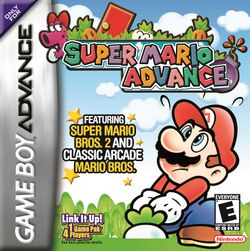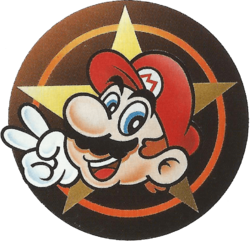(new features link) |
BrownDerby (talk | contribs) m (nso) |
||
| (21 intermediate revisions by 8 users not shown) | |||
| Line 1: | Line 1: | ||
{{Header Nav|game=Super Mario Advance | {{Header Nav|game=Super Mario Advance}} | ||
{{ | {{Game | ||
|completion=4 | |||
|image=Super Mario Advance Box Art.jpg | |||
|title=Super Mario Advance | |title=Super Mario Advance | ||
|developer=[[Nintendo R&D2]] | |||
|developer=[[Nintendo]] | |||
|publisher=[[Nintendo]] | |publisher=[[Nintendo]] | ||
| | |year=2001 | ||
| | |systems={{syslist|gba|wiiu|switch}} | ||
|ratings={{ESRB|E}} | |||
|genre=[[Platform]] | |genre=[[Platform]] | ||
|players=1-2 | |players=1-2 | ||
| | |modes=[[Single player]], [[Multiplayer]] | ||
|followed by=[[Super Mario Advance 2]] | |followed by=[[Super Mario Advance 2]] | ||
|series=Mario | |series=Mario | ||
}} | }} | ||
In 2001, [[Super Mario Bros. 2]] received another enhanced remake as part of '''Super Mario Advance''' (also containing a remake of [[Mario Bros]]). ''Super Mario Advance'' was developed by [[Nintendo R&D2]], and represented the first ''Mario'' title for the [[Game Boy Advance]]. | |||
The ''Super Mario Advance'' version of ''SMB2'' includes several new features: | |||
* Multiplayer mode available when up to four Game Boy Advances are connected with a link cable. | |||
* The addition of the new enemy, Robirdo (a robotic Birdo acting as the boss of world three). | |||
* The addition of the ''[[/Yoshi's Challenge/]]'' (in which players may revisit stages to search for Yoshi eggs). | |||
* An an all-new point-scoring system (a first for the game). | |||
* Graphical and audio enhancements were added in the form of enlarged sprites, multiple hit combos, digital voice acting, and such minor stylistic and aesthetic changes as an altered default health-meter level, boss-order, backgrounds, the size of hearts, Princess Toadstool being renamed to the now-standard "Princess Peach," and the inclusion of a chime to announce starmen, were also added. | |||
The game also includes a full version of the original ''[[Mario Bros.]]'' arcade game from [[1983]], with updated audiovisuals and Mushroom Kingdom-based enemies replacing the generic creatures of the original (Spinys taking the place of Shellcreepers, for example); this game would be included in all three subsequent ''Super Mario Advance'' titles, including ''Mario & Luigi: Superstar Saga''. | |||
''Super Mario Advance'' was a best-selling launch game, and became part of the GBA's Player's Choice lineup as one of the console's first three Player's Choice games (along with ''[[Mario & Luigi: Superstar Saga]]'' and ''[[Super Mario Advance 3]]''). | |||
Refer to the [[/New features/]] page for differences between the Nintendo Entertainment System, Super Nintendo, and Game Boy Advance version. | |||
<gallery> | |||
File:Super Mario Advance title screen.png|Initial title screen. | |||
File:Super Mario Advance game select.png|Game select screen. | |||
File:Super Mario Advance character select.png|Character select screen. | |||
</gallery> | |||
{{ToC}} | {{ToC}} | ||
{{Mario}} | {{Mario}} | ||
[[Category:Nintendo Research & Development 2]] | |||
[[Category:Nintendo]] | [[Category:Nintendo]] | ||
[[Category:Platform]] | [[Category:Platform]] | ||
[[Category:Single player]] | [[Category:Single player]] | ||
[[Category:Multiplayer]] | [[Category:Multiplayer]] | ||
Latest revision as of 04:00, 19 May 2023

| Super Mario Advance | |
|---|---|
| Developer(s) | Nintendo R&D2 |
| Publisher(s) | Nintendo |
| Year released | 2001 |
| System(s) | Game Boy Advance, Wii U, Nintendo Switch |
| Followed by | Super Mario Advance 2 |
| Series | Mario |
| Genre(s) | Platform |
|---|---|
| Players | 1-2 |
| Modes | Single player, Multiplayer |
| Rating(s) |
In 2001, Super Mario Bros. 2 received another enhanced remake as part of Super Mario Advance (also containing a remake of Mario Bros). Super Mario Advance was developed by Nintendo R&D2, and represented the first Mario title for the Game Boy Advance.
The Super Mario Advance version of SMB2 includes several new features:
- Multiplayer mode available when up to four Game Boy Advances are connected with a link cable.
- The addition of the new enemy, Robirdo (a robotic Birdo acting as the boss of world three).
- The addition of the Yoshi's Challenge (in which players may revisit stages to search for Yoshi eggs).
- An an all-new point-scoring system (a first for the game).
- Graphical and audio enhancements were added in the form of enlarged sprites, multiple hit combos, digital voice acting, and such minor stylistic and aesthetic changes as an altered default health-meter level, boss-order, backgrounds, the size of hearts, Princess Toadstool being renamed to the now-standard "Princess Peach," and the inclusion of a chime to announce starmen, were also added.
The game also includes a full version of the original Mario Bros. arcade game from 1983, with updated audiovisuals and Mushroom Kingdom-based enemies replacing the generic creatures of the original (Spinys taking the place of Shellcreepers, for example); this game would be included in all three subsequent Super Mario Advance titles, including Mario & Luigi: Superstar Saga.
Super Mario Advance was a best-selling launch game, and became part of the GBA's Player's Choice lineup as one of the console's first three Player's Choice games (along with Mario & Luigi: Superstar Saga and Super Mario Advance 3).
Refer to the New features page for differences between the Nintendo Entertainment System, Super Nintendo, and Game Boy Advance version.
-
Initial title screen.
-
Game select screen.
-
Character select screen.
Table of Contents
- Super Mario Bros.
- Super Mario Bros. 2 (Japan) (The Lost Levels)
- Super Mario Bros. 2
- Super Mario Bros. 3
- Super Mario World
- Super Mario All-Stars
- Yoshi's Island
- Super Mario Land
- 6 Golden Coins
- Super Princess Peach
- Super Mario Maker
- Super Mario Run
- Super Mario Maker 2
- Super Mario Bros. 35
- Super Mario Bros. Wonder
- Princess Peach: Showtime!



